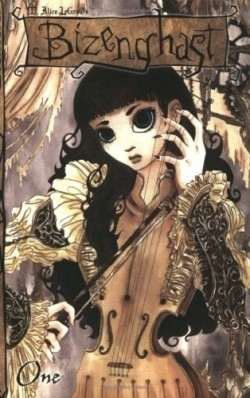Bizenghast
- 2005 INDIES Finalist
- Finalist, Graphic Novels & Comics (Adult Nonfiction)
Dinah Wherever’s parents died in a tragic automobile accident. More tragic yet is that she’s now in the care of her aunt, Jane Addison, and living at St. Lyman’s School for Boys, which was “renovated into a home” once Jane took custody of Dinah. Therein lies the danger, for the home is haunted, and only Dinah can see the ghosts. Her aunt thinks she’s mad, and threatens to have her committed. The bruises and wounds that Dinah suffers, thinks Jane, are self-inflicted.
In this superb offering, first in a trilogy, the author has combined elements from classic manga with Gothic art and architecture to create a style all her own—full of detail and feeling to match the pathos of her truly Gothic tale. *Manga-*style big-eyed characters in magnificent Victorian costume populate the pages as Dinah and her friend Vincent try to free the souls of the dead who linger everywhere, it seems, on the property. In epistolary interludes, LeGrow lets readers know that St. Lyman’s was part of the state’s Reform School, cobbled together at a former asylum when the state required the “separation of the mentally feeble and the criminally ill.” The ghosts range from sinister to sad, but their threat is very real; both Dinah’s life and sanity are at stake. Madness and murder abound in the phantasmic lives of the poor souls imprisoned within the ruins of Bizenghast.
The once-thriving mill town is desolated and decaying. Since Dinah’s home lies on its outskirts, she finds it extremely depressing, but she and Vincent explore the countryside nonetheless—where else can they go? On one of their clandestine trips, they stumble on a long-lost cemetery with unusual gravestones, gates protected by strange dragon-ish creatures, and a sunken mausoleum guarded by a mourning angel. Vincent goes in; Dinah follows, despite her fears, into an arched and ornamented sunken chamber. A curious verse on a plaque that holds a key draws Dinah’s attention; she touches the key. This single touch binds her in the contract of which the verse speaks, and causes a huge spider-creature to pounce, terrifying both young people. The creature, Bali-Lali, informs Dinah that she is now compelled to free all the souls bound within the confines of the crypt—or die.
As Dinah and Vincent struggle to free the souls, one every night, they find each quest different, each story more horrific than the last: a girl who was murdered by her father; a young man who killed himself and his beloved; and a group of children who drowned in a woodsy pool at the hands of a “faerie woman.” The two manage to find the key to each spirit’s release, yet so many must be freed that at the end of the first book their job has barely begun.
Vincent, untiring in his service to Dinah and to the poor bound souls awaiting release, struggles with his own problems: His parents have been gone traveling for months, leaving him on his own with only periodic infusions of money. He’s built himself a little house outside, furnished with oddments salvaged from the town, and refuses to stay in a proper house. Dinah is apparently the only one who knows his true situation, just as he is the only one who knows that she sees, and is attacked by, ghosts in her house. Their shared secrets give them another bond in their work to free the mausoleum’s ghosts.
Dinah’s fears—she’s a timid sort, not terribly unselfish, though she struggles to be better—often get the better of her, till Vincent offers to take the contract upon himself to release the rest of the ghosts and free her from her charge. Knowing, however, that this means that Vincent will be the one facing death if he fails, Dinah refuses his offer, and perseveres.
The author, born in Germany, holds a BFA in Sequential Art from the Savannah College of Art and Design; she was featured in the publisher’s Rising Stars of Manga anthology. Her artwork here is truly extraordinary. Delicate lines, bold black accents, and incredible detail convey magic, emotion, and the ethereal. LeGrow’s settings are magnificent, whether ruined, crumbling mansions, woodland glens, underwater grottoes, thin church spires, or weeping angels and tombstones. Costumes are inventive and beautiful, whether lace or brocade or elegant and simple. LeGrow’s storytelling is just as inventive and enticing. Readers will be eager for future installments, as much for their eye appeal as for the continuation of the tale.
Disclosure: This article is not an endorsement, but a review. The publisher of this book provided free copies of the book to have their book reviewed by a professional reviewer. No fee was paid by the publisher for this review. Foreword Reviews only recommends books that we love. Foreword Magazine, Inc. is disclosing this in accordance with the Federal Trade Commission’s 16 CFR, Part 255.

